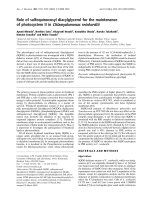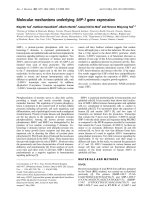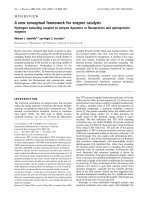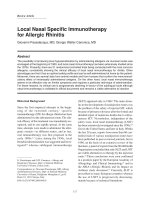Báo cáo y học: "Local Nasal Specific Immunotherapy for Allergic Rhinitis" potx
Bạn đang xem bản rút gọn của tài liệu. Xem và tải ngay bản đầy đủ của tài liệu tại đây (343.99 KB, 7 trang )
117
Historical Background
Since the first empirical attempts at the begin-
ning of the twentieth century,
1
specific
immunotherapy (SIT) for allergic rhinitis has been
administered via the subcutaneous route. The clin-
ical efficacy of this treatment was immediately rec-
ognized, and its use rapidly spread. At the same
time, attempts were made to administer the aller-
genic extracts via different routes, and in fact,
oral immunotherapy was first proposed in the
early 1900s.
2,3
Later, during the 1950s, local
bronchial desensitization was suggested and inves-
tigated
4,5
whereas sublingual immunotherapy
(SLIT) appeared only in 1986.
6
The main stimu-
lus to the development of noninjection routes was
the problem of the safety of injected SIT, which
became of primary relevance after the formal and
detailed report of numerous deaths due to subcu-
taneous SIT.
7
Nevertheless, independent of the
safety issue, local nasal immunotherapy (LNIT)
has been extensively investigated since the 1970s,
8,9
first in the United States and later in Italy. Within
the last 20 years, reports from more than 60 con-
trolled trials of various noninjection routes have
been published in peer-reviewed journals, but in
1998, on the basis of an extensive review of the
literature, a panel of experts from the World Health
Organization concluded that only SLIT and LNIT
are viable alternatives to therapy by the injection
route.
10
These conclusions were soon confirmed
in a position paper by the European Academy of
Allergology and Clinical Immunology
11
and in
the ARIA (Allergic Rhinitis and Its Impact on
Asthma) study document.
12
Currently, SLIT is
prescribed in many European countries whereas
the use of LNIT is progressively decreasing,
mainly because of technical limitations.
Review Article
Local Nasal Specific Immunotherapy
for Allergic Rhinitis
Giovanni Passalacqua, MD; Giorgio Walter Canonica, MD
Abstract
The possibility of producing local hyposensitization by administering allergens via mucosal routes was
envisaged at the beginning of 1900, and local nasal immunotherapy has been extensively studied since
the 1970s. Presently, there are 21 randomized controlled trials being conducted with the most common
allergens, consistently showing the clinical efficacy of local nasal immunotherapy for rhinitis. Other
advantages are that it has an optimal safety profile and can be self-administered at home by the patient.
Moreover, there are several data from animal models and from humans that confirm the immunomod-
ulatory effect of intranasally administered antigens. On the other hand, local nasal immunotherapy
seems to be effective only on rhinitis symptoms and requires a particular technique of administration.
For these reasons, its clinical use is progressively declining in favour of the sublingual route although
nasal immunotherapy is validated in official documents and remains a viable alternative to injection.
G. Passalacqua and G.W. Canonica—Allergy and
Respiratory Diseases, Dept. of Internal Medicine,
University of Genoa, Genoa, Italy;
Correspondence to: Giovanni Passalacqua, MD, Allergy
and Respiratory Diseases, Dept. of Internal Medicine,
University of Genoa, Padiglione Maragliano, L.go R.
Benzi 10, 16132 Genoa, Italy
DOI 10.2310/7480.2006.00010
118 Allergy, Asthma, and Clinical Immunology / Volume 2, Number 3, Fall 2006
Practical Aspects
LNIT is the administration (by spray) of grad-
ually increasing amounts of allergen (build-up
or up-dosing phase) into the nasal cavity until a
maintenance dose is reached. The maintenance
dose is then given continually at variable inter-
vals to maintain “hyposensitization” and to
reduce symptoms due to natural exposure to the
allergen. The few nasal vaccines are commer-
cialized in Europe and standardized either bio-
logically or immunologically. Like the extracts
used for subcutaneous immunotherapy, they are
labelled in arbitrary units, according to in-house
references. LNIT is given as a nasal spray that
can be either an aqueous solution or a dry pow-
der. LNIT can be administered either presea-
sonally (stopping at the beginning of the season),
“pre-coseasonally” (stopping at the end of the
season), or continually. Pre-coseasonal schedules
are the choice for pollen allergy whereas con-
tinuous treatments are preferred for perennial
allergens. The build-up phase usually lasts about
4 to 6 weeks, and the vaccine is prepared in
separate vials or blisters at increasing concen-
trations (Figure 1). Simplified schedules of
administration (steady dosage) have also been
proposed, to make LNIT more “patient friendly.”
Detailed education of the patient is mandatory
because LNIT is self-administered at home by
the patient. Administration requires good train-
ing and some precautions so that inhalation into
the deep airways (ie, the patient’s vocalizing
while spraying) is avoided. Dry-powder cap-
sules used with a spraying device make admin-
istration quite easy (Figure 2). Some authors
have suggested premedication with nasal cro-
molyn before each dose, but there is no strict sci-
entific support for this.
Efficacy and Safety
To date, there have been 21 randomized double-
blind placebo-controlled studies with LNIT (Table
1).
13–33
All but two
16,24
invariantly documented a
significant reduction of symptoms and/or drug
intake scores. In this regard, the clinical efficacy
of LNIT for rhinitis symptoms was comparable
to that of subcutaneous SIT. In parallel, several
trials demonstrated a measurable reduction of the
nasal response to specific challenge,
24–32
con-
firming the effectiveness of hyposensitization.
The large majority of LNIT studies were con-
ducted among subjects with pollinosis, and the
treatment was proved to be effective with all the
major pollens (including birch, ragweed, grasses,
and
Parietaria judaica). There were also four
studies performed with a mite extract, three with
favourable results
20,31,32
and one with negative
results,
24
but in this latter study, LNIT was admin-
Figure 1 Example of an administration schedule for
local nasal immunotherapy (LNIT) with an aqueous
extract prepared at different concentrations. UB = bio-
logic units; Wk = weeks.
Figure 2 Diagram of a delivery device for extracts pre-
pared as dry-powder capsules (Allerkin, Lofarma S.p.A,
Milan, Italy).
Local Nasal Specific Immunotherapy for Allergic Rhinitis — Passalacqua and Canonica 119
istered for 3 months only. Few studies (all with
positive results) were carried out with children,
27,32
and there is insufficient experience with the pedi-
atric age group. LNIT seems to be effective only
locally (ie, for rhinitis symptoms); there is no
proof that it is also able to treat asthma. There is
one study (uncontrolled, with 43 pollinosis
patients) that shows a reduction of nonspecific
bronchial hyperresponsiveness following LNIT.
34
Concerning the duration of clinical efficacy, the
only available follow-up of a randomized con-
trolled trial suggested that LNIT does not main-
tain its clinical efficacy once it is discontinued and
that a preseasonal course is needed every year.
35
On the other hand, a prospective observational
study (not randomized and not controlled) docu-
mented 3 to 5 years of long-lasting clinical effi-
cacy in 22 patients after discontinuation of LNIT.
36
Aqueous extracts of unmodified allergens are
highly effective, but they also provoke mild LNIT-
induced rhinitis whereas treatment with aller-
goids (chemically modified allergens) is almost
devoid of local side effects (however, allergoids
are less potent). These facts, observed in the ear-
liest studies, raised some concerns about the clin-
ical use of LNIT
37
because although the symptoms
were reduced during the allergen exposure, they
were present (even if mild) at every LNIT admin-
istration. Extracts that are prepared as dry pow-
der solved the problem; the granules (with a diam-
eter of 40–50 µm) allow a uniform deposition on
the nasal mucosa and do not provoke clinical
symptoms. In fact, no side effects or only negli-
gible side effects were reported in all the studies
that used dry powders. In one study, three patients
withdrew because of bronchospasm after admin-
istration, but this side effect was attributed to
incorrect technique (ie, improper inhalation of
the allergen).
22
LNIT seems to be well tolerated
and to have a reasonable safety profile.
11,12
Table 1 Double-Blind Placebo-Controlled Studies of Local Nasal Immunotherapy
No. of
Patients
(Active/
Author, Year Age Range (yrs) Placebo) Allergen Duration Type of Extract
Johansson, 1979
13
Ad 12/11 Grass 14 wk Aqueous, modified
Nickelsen, 1981
14
16–66 38/34 Ragweed 3 mo Aqueous, modified
Welsh, 1981
15
13–58 18/15 Ragweed 20 wk Aqueous
Schumacher, 1982
16
20–53 8/7 Grass 10 wk Powder, modified
Georgitis, 1983
17
16–67 31/13 Grass 10 wk Aqueous, modified
Georgitis, 1984
18
Ad 29/16 Grass 10 wk Aqueous, modified
Andri, 1992
19
14–54 8/8 Parietaria 18 wk Powder, modified
Andri, 1993
20
15–54 11/10 Mite 12 mo Powder
Passalacqua, 1995
21
20–56 9/9 Parietaria 5 mo Powder
D’Amato, 1995
22
13–37 10/10 Parietaria 8 mo Powder
Andri, 1995
23
17–56 14/14 Birch 22 wk Powder
Fanales-Belasio, 1995
24
16–49 10/10 Mite 3 mo Aqueous
Andri, 1996
25
14–52 13/15 Grass 4 mo Powder
Cirla, 19962
6
17–44 11/11 Birch/alder 4 mo Powder
Bardare, 1996
27
5–15 19/20 Grass 3 mo Powder
Gaglani, 1997
28
18–35 13/14 Weed mix 4 mo Aqueous
Bertoni, 1999
29
18–43 10/10 Grass 3 mo Aqueous
Motta, 2000
30
13–55 55/47 Grass/mite 8 mo Aqueous
Pocobelli, 2001
31
16–45 22/21 Grass 4 mo Powder, modified
Marcucci, 2002
32
4–15 16/16 Mite 18 mo Powder, modified
Passali, 2002
33
16–47 18/18 Mite 8 mo Powder, modified
Ad = advanced age; wk = weeks.
In the more recent studies, a simplified sched-
ule of administration was used, with a single and
steady dosage from the beginning.
31,33
This admin-
istration schedule is advantageous for patients
because different preparations at different con-
centrations are no longer required and because
accidental dosing mistakes are avoided. The clin-
ical equivalence between the steady dosage and the
traditional build-up was demonstrated in a ran-
domized open trial.
38
Immunologic Aspects
As mentioned above, the first attempts to achieve
a selective hyposensitization of the nasal mucosa
were made at the beginning of the 1970s.
8,9
The
underlying rationale was derived from the obser-
vation that hyporesponsiveness of the nasal mucosa
could be achieved after repeated stimulation with
low doses of allergen.
39
From a clinical view-
point, this is the opposite of the well-known prim-
ing effect, whereby an increased mucosal response
is seen after a single administration of allergen.
40
The changes in nasal allergic response over
time were confirmed in a challenge-rechallenge
study.
41
In this trial, allergic patients received a
baseline nasal challenge and a rechallenge after 3,
7, 14, or 28 days. If the rechallenge was made after
3 days, the clinical response was greater than
baseline (priming effect) whereas there was a sig-
nificantly decreased response at 14 days. The
7- and 28-day challenges evoked a clinical
response identical to that of the baseline chal-
lenge (Figure 3). In general, the local administra-
tion of allergens is supported by a number of
experimental observations in animal models, show-
ing the “tolerogenicity” of mucosal antigen deliv-
ery.
42,43
In an animal model, it was seen that
mucosal administration of the antigen could select
a functionally disabled population of CD4
+
cells.
44
Also, in animal models, intranasal administration
of antigens was found to induce an increased pro-
duction of interleukin-10,
45,46
the regulatory and
antiinflammatory cytokine involved in the mech-
anisms of action of traditional SCIT.
47,48
Systemic
immunologic changes induced by LNIT in humans
were reported only sporadically in the above-
mentioned clinical trials. In one open study of
LNIT and SCIT, it was shown that only SCIT
could induce an increase in circulating
immunoglobulin G4.
49
Nevertheless, patients
treated with LNIT also showed decreased prolif-
eration of allergen-specific T-lymphocyte clones
after treatment. In one clinical trial, it was shown
that LNIT is capable of modulating allergic inflam-
mation by down-regulating the expression of inter-
cellular adhesion molecule 1.
35
Despite their wide
clinical use, nothing is known about the absorp-
tion and fate of SCIT allergenic extracts in humans.
Indeed, their biodistribution would be of particu-
lar importance in the case of local administration.
In rats and rabbits, significant absorption of the
allergen through sublingual and nasal mucosae
has been shown.
50
This is in agreement with the
increased permeability of nasal epithelium to
macromolecules that is observed in allergic sub-
jects,
51
but there is still controversy concerning the
pharmacokinetics of allergens.
52
In recent years,
the biodistribution of mucosal antigens was
assessed in humans with the use of a radiolabelled
purified allergen (Par j 1) and a special proce-
dure.
53
With this design, it was observed that no
direct absorption of the allergen through the sub-
lingual mucosa occurs and that plasma radioac-
tivity increases only after the allergen is swal-
lowed. This is also true for nasal administration.
120 Allergy, Asthma, and Clinical Immunology / Volume 2, Number 3, Fall 2006
Figure 3 Graph showing how the intensity of nasal
response to rechallenge is different at different times.
If the rechallenge is made 2 weeks after the first chal-
lenge, a significant reduction in the response is seen.
Adapted from Nickelsen JA et al.
41
d = days; NS =
Local Nasal Specific Immunotherapy for Allergic Rhinitis — Passalacqua and Canonica 121
In healthy volunteers, the allergen sprayed into the
nose is slowly transported by mucociliary clear-
ance towards the pharynx (Figure 4) and is pro-
gressively swallowed, but a fraction is retained for
long periods (up to 40 hours) in the mucosa.
53,54
Things are partly different in allergic subjects;
the allergen is cleared from the nose faster than in
nonallergic persons, and it disappears completely
from the nose within minutes.
55
Conclusions
On the basis of the literature review, it can be said
that local nasal immunotherapy (LNIT) is clearly
effective in treating allergic rhinitis because it alle-
viates symptoms and reduces the need for con-
comitant medications during natural exposure to
allergens. Another favourable aspect of LNIT is its
safety, which has been repeatedly confirmed in
numerous trials. Moreover, LNIT is self-adminis-
tered by patients in their homes, thus avoiding the
costs for injections and loss of time. On the other
hand, LNIT is effective only for rhinitis whereas
patients often have concomitant allergic diseases
such as asthma and conjunctivitis. In addition, a spe-
cific administration technique is needed to avoid
inhalation of the extract into the deep airways
whereas sublingual immunotherapy (SLIT) is more
easily used and has a systemic effect. For these rea-
sons, the clinical use of LNIT is progressively
declining in favour of SLIT. In Italy, LNIT currently
accounts for about 10% of immunotherapy sales.
Nevertheless, it remains a viable alternative to
subcutaneous therapy. The optimal candidates are
adult and well-trained patients with pollen-induced
rhinitis and patients who refuse injections or who
cannot tolerate the subcutaneous regimen.
References
1. Noon L. Prophylactic inoculation against hay
fever. Lancet 1911;i:1572–3.
2. Black JH. The oral administration of pollen. J
Lab Clin Med 1927;12:1156.
3. Black JH. The oral administration of pollen: clin-
ical report. J Lab Clin Med 1928;13:709.
4. Herxeimer H. Bronchial hypersensitization and
hyposensitization in man. Int Arch Allergy Appl
Immunol 1951;40:40–57.
5. Herxeimer H, Prior EN. Further observations in
induced asthma and bronchial hyposensitization.
Int Arch Allergy Appl Immunol 1952;3:159–61.
6. Scadding K, Brostoff J. Low dose sublingual
therapy in patients with allergic rhinitis due to
dust mite. Clin Allergy 1986;16:483–91.
7. Committee on the Safety of Medicines. CSM update.
Desensitizing vaccines. Br Med J 1986;293:948.
8. Metha SB, Smith JM. Nasal hyposensitization
and hayfever. Clin Allergy 1975;5:279–84.
9. Taylor G, Shivalkar PR. Local nasal desensitiza-
tion in allergic rhinitis. Clin Allergy 1972;2:125–6.
10. Bousquet J, Lockey R, Malling HJ. Allergen
immunotherapy: therapeutic vaccines for aller-
gic diseases. World Health Organization position
paper. Allergy 1998;53 Suppl:
11. Malling HJ, Abreu-Nogueira J, Alvarez-Cuesta
E, et al. EAACI position paper on local
immunotherapy. Allergy 1998;53:933–44.
12. Bousquet J, Van Cauwenberge P. Allergic rhini-
tis and its impact on asthma. J Allergy Clin
Immunol 2001;108:S83–5.
13. Johansson SG, Deuschl H, Zetterstrom O. Use
of glutaraldehyde-modified timothy grass pollen
extract in nasal hyposensitization of hay fever.
Int Arch Allergy Appl Immunol 1979;60:447–60.
14. Nickelsen JA, Goldstein S, Mueller U, et al. Local
intranasal immunotherapy for ragweed allergic
rhinitis: clinical response. J Allergy Clin Immunol
1981;68:33–40.
Figure 4 Pharmacokinetics of radiolabelled Par j 1 in
a nonallergic volunteer. Sequential scintiscans of the
nasal region, recorded at different times (up to 30 min-
utes) after administration, show a progression of the
allergen toward the pharynx.
122 Allergy, Asthma, and Clinical Immunology / Volume 2, Number 3, Fall 2006
15. Welsh PW, Zimmermann EM, Yunginger JW, et
al. Preseasonal intranasal immunotherapy with
nebulized short ragweed extract. J Allergy Clin
Immunol 1981;67:237–42.
16. Schumacher MJ, Pain MC. Intranasal
immunotherapy and polymerized grass pollen
allergens. Allergy 1982;37:241–8.
17. Georgitis JW, Reisman RE, Clayton WF, et al.
Local nasal immunotherapy for grass allergic
rhinitis. J Allergy Clin Immunol 1983;71:71–6.
18. Georgitis JW, Clayton WF, Wypich JI, et al.
Further evaluation of local nasal immunother-
apy with aqueous and allergoid grass extract. J
Allergy Clin Immunol 1984;74:694–700.
19. Andri L, Senna GE, Betteli C, et al. Local nasal
immunotherapy in allergic rhinitis to
Parietaria.
Allergy 1992;47:318–23.
20. Andri L, Senna GE, Betteli C, et al. Local nasal
immunotherapy for
Dermatophagoides-induced
rhinitis: efficacy of a powder extract. J Allergy
Clin Immunology 1993;91:587–96.
21. Passalacqua G, Albano M, Ruffoni S, et al. Local
nasal immunotherapy to
Parietaria: evidence of
reduction of allergic inflammation. Am J Respir
Crit Care Med 1995;152:461–6.
22. D’Amato G, Lobefalo G, Liccardi G, Cazzola M.
A double blind placebo controlled trial of local
nasal immunotherapy in allergic rhinitis to
Parietaria pollen. Clin Exp Allergy 1995;25:141–8.
23. Andri L, Senna GE, Andri G, et al. Local nasal
immunotherapy for birch allergic rhinitis with
extract in powder form. Clin Exp Allergy
1995;25:1092–9.
24. Fanales-Belasio E, Ciofalo A, Zambetti G,
et al. Intranasal immunotherapy with
Dermatophagoides extract: in vivo and in vitro
results of a double-blind placebo-controlled trial.
Rhinology 1995;33:126–31.
25. Andri L, Senna GE, Betteli C, et al. Local nasal
immunotherapy with extract in powder form is
effective and safe in grass pollen rhinitis. A double
blind study on 32 patients. J Allergy Clin
Immunol 1996;97:37–41.
26. Cirla A, Sforza N, Roffi GP, et al. Preseasonal
intranasal immunotherapy in birch-alder rhinitis.
A double blind study. Allergy 1996;51:299–305.
27. Bardare M, Zaini C, Novembre E, Vierucci A.
Local nasal immunotherapy with a powder extract
for grass pollen rhinitis in pediatric ages. A con-
trolled study. J Invest Allergol Clin Immunol
1996;97:34–41.
28. Gaglani B, Borish L, Bartelson BL, et al. Nasal
immunotherapy in weed-induced allergic rhinitis.
Ann Allergy Asthma Immunol 1997;79:259–65.
29. Bertoni M, Cosmi F, Bianchi I, Di Berardino L.
Clinical efficacy and tolerability of a steady dosage
schedule of local nasal immunotherapy. Results
of preseasonal treatment in grass pollen rhinitis.
Ann Allergy Asthma Immunol 1999;82:47–51.
30. Motta G, Passali D, De Vincentiis I, et al. A mul-
ticenter trial of specific local nasal
immunotherapy. Laryngoscope 2000;110:132–9.
31. Pocobelli D, Del Bono A, Venuti L, et al. Nasal
immunotherapy at constant dosage: a double
blind placebo controlled study in grass allergic
rhinoconjunctivitis. J Invest Allergol Clin
Immunol 2001;11:79–88.
32. Marcucci F, Sensi LG, Caffarelli C, et al. Low-
dose local nasal immunotherapy in children
with perennial allergic rhinitis due to
Dermatophagoides. Allergy 2002;57:23–8.
33. Passali D, Bellussi L, Passali GC, Passali FM.
Nasal immunotherapy is effective in the treat-
ment of rhinitis due to mite allergy. A
double-blind, placebo-controlled study with rhi-
nological evaluation. Int J Immunopathol
Pharmacol 2002;15:141–7.
34. Olivieri M, Mohaddes Zadeh MR, Talamini G,
et al. Local nasal immunotherapy and bronchial
hyperreactivity in seasonal allergic rhinitis: an
observational pilot study. J Investig Allergol Clin
Immunol 2000;10:300–4.
35. Passalacqua G, Albano M, Pronzato C, et al.
Nasal immunotherapy to
Parietaria: long term
follow up of a double blind study. Clin Exp
Allergy 1997;27:904–8.
36. Andri L, Falagiani P. Symptomatic relief after
grass nasal immunotherapy: lasting efficacy after
4-5 years. J Investig Allergol Clin Immunol
2003;13:228–31.
37. Bjorksten B. Local immunotherapy is not docu-
mented for clinical use. Allergy 1994;49:299–301.
38. Senna GE, Andri L, Dama A, et al. Local nasal
immunotherapy: efficacy and tolerability of two
different administration schedules in grass pollen
rhinitis. Allergol Immunopathol (Madr)
2000;28:238–42.
39. Taylor G, Shivalkar E. Changes in nasal airways
resistance on antigenic challenge in allergic rhini-
tis. Clin Allergy 1971;1:63–73.
40. Koh YY, Lim HS, Min KU, Min YG. Airways
of allergic rhinitics are ‘primed’ to repeated aller-
Local Nasal Specific Immunotherapy for Allergic Rhinitis — Passalacqua and Canonica 123
gen inhalation challenge. Clin Exp Allergy
1994;24:337–46.
41. Ciprandi G, Ricca V, Landi M, et al. Allergen
specific nasal challenge: response kinetic of clin-
ical and inflammatory events to rechallenge. Int
Arch Allergy Immunol 1998;115:157–61.
42. Holt PG, Sedgwick JD. Suppression of IgE
response following antigen inhalation: a natural
homeostatic mechanism which limits sensitiza-
tions to aeroallergens. Immunol Today 1987;8:14–5.
43. Holt PG, Reid M, Britten D, et al. Suppression
of IgE responses by passive antigen inhalation:
dissociation of local and systemic immunity. Cell
Immunol 1987;104:434–9.
44. Tsitoure DC, DeKruyff RH, Lamb JR, Umetsu
DT. Intranasal exposure to antigen induces
immunological tolerance mediated by function-
ally disabled CD4+ T cells. J Immunol
1999;163:2592–600.
45. Barbey C, Donatelli-Dufour N, Batard P, et al.
Intranasal treatment with ovalbumin but not the
major T cell epitope ovalbumin 323-339 gener-
ates interleukin-10 secreting T cells and results
in the induction of allergen systemic tolerance.
Clin Exp Allergy 2004;34:654–62.
46. Hall G, Houghton CG. Suppression of allergen
reactive Th2 mediated responses and pulmonary
eosinophilia by intranasal administration of an
immunodominant peptide is linked to IL-10 pro-
duction. Vaccine 2003;21:549–61.
47. Till SJ, Francis JN, Nouri-Aria K, Durham SR.
Mechanisms of immunotherapy. J Allergy Clin
Immunol 2004;113:1025–34.
48. Robinson DS, Larche M, Durham SR. Tregs and
allergic disease. J Clin Invest 2004;114:1389–97.
49. Giannarini L, Maggi E. Decrease of allergen spe-
cific T cell response induced by nasal
immunotherapy. Clin Exp Allergy
1998;28:404–12.
50. Mistrello G, Rapisarda G, Falagiani P. Detection
of IgE-binding activity in serum after intranasal
treatment of normal rabbits with
P. judaica
extracts. Allergy 1991;46:52–5.
51. Buckle FB, Cohen AB. Nasal mucosal hyper-
permeability to macromolecules in atopic rhinitis
and extrinsic asthma. J Allergy Clin Immunol
1975;55:213–21.
52. Falagiani P, Mistrello G. Pharmacokinetics of
allergens after local administration. Allergy
1997;52:17–21.
53. Bagnasco M, Mariani G, Passalacqua G, et al.
Absorption and distribution kinetics of
the major
Parietaria allergen administered
by noninjectable routes to healthy human
beings. J Allergy Clin Immunol 1997;
100:122–9.
54. Bagnasco M, Passalacqua G, Villa G.
Pharmacokinetics of an allergen and a
monomeric allergoid for oromucosal
immunotherapy in allergic volunteers. Clin Exp
Allergy 2001;31:54–60.
55. Passalacqua G, Altrinetti V, Mariani G, et al.
Pharmacokinetics of radiolabelled
Par j 1 administered intranasally to allergic
and healthy subjects. Clin Exp Allergy
2005;35:880–3.








